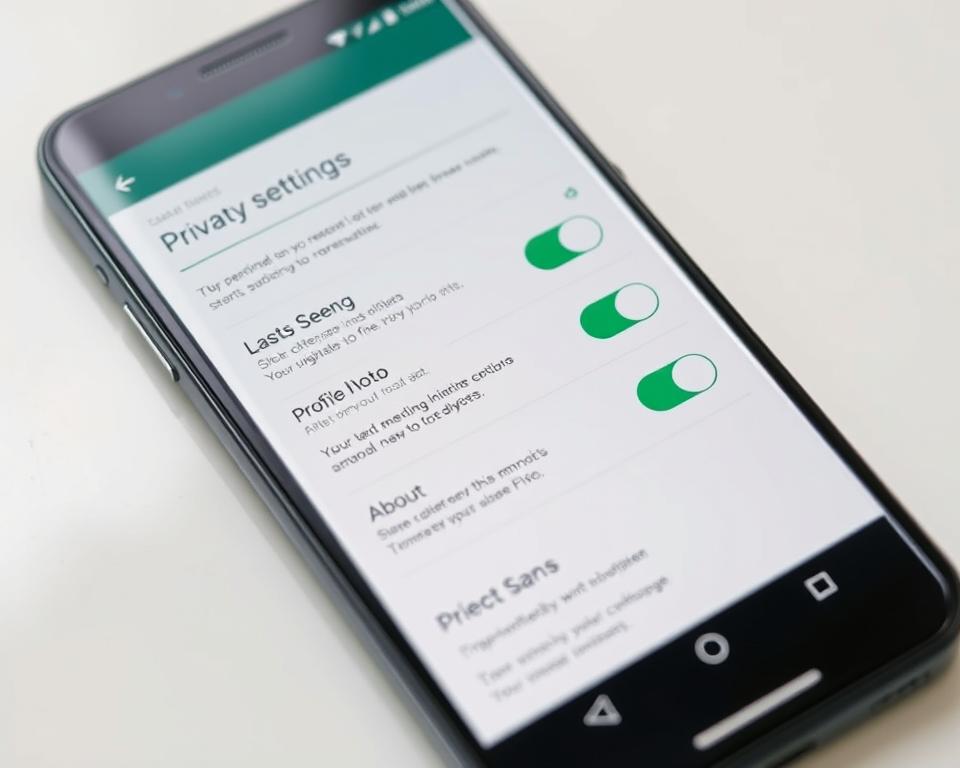Advertisements
In the digital age, the safety of minors is a priority. The 60% of adolescents You've had contact with strangers on messaging platforms. Are you sure you know all the risks?
Many parents underestimate the hidden dangers behind a screen. From cyberbullying to inappropriate content, the threats are real and growing every day.
Advertisements
This article will show you effective methods to protect your family. You'll learn to combine technical tools with open communication, without damaging the trust your loved ones have with you.
1. Set WhatsApp privacy settings to protect your children
Protecting personal information is essential in messaging apps. With proper settings, you can reduce risks and maintain control over what others can see.
Access the privacy settings
Open the app and follow these steps:
Advertisements
- Tap the three dots in the top right corner
- Select Configuration
- Choose the option Privacy
This menu contains seven important settings. Each affects how others interact with the account.
Customize the visibility of information
Main options include:
- Last time: Control who sees when you were active
- Profile picture: Decide which contacts can see it
- Information: Limits access to personal data
For teenagers, I recommend selecting Only my contacts in each category. This prevents strangers from accessing sensitive details.
A common mistake is to leave it activated last seen. Turning it off reduces the pressure to respond to messages immediately.
Advanced protection options
Don't forget these additional settings:
- Status: Limit to trusted contacts
- Read receipts: Useful for controlling interactions
- Silence Unknown: Block messages from unsaved numbers
Review these settings monthly. Updates may change previous settings.
2. Block and report unwanted contacts
In the digital world, unknown contacts can pose a real risk to young people. Learning to manage these situations protects their well-being and privacy.
How to block a contact
Follow these steps to restrict unwanted interactions:
- Open the person's chat.
- Touch See contact > Block.
- Confirm the action. The contact will not be able to send messages or make calls.
Tip: Blocking is reversible. If the situation improves, you can deactivate it at any time.
How to report a contact
If you receive inappropriate content, reporting it helps keep you safe:
- WhatsApp reviews the last 5 messages when sending the report.
- Select Report and uncheck “Delete chat” if you need to save evidence.
This feature is useful in cases of bullying or grooming. The 85% of the reports receive a response within 24 hours.
What to do if you need to keep messages as evidence
To collaborate with authorities:
- Save screenshots or make a physical copy.
- Use formats like PDF to preserve metadata.
ImportantAvoid editing messages. Evidence integrity is key.
3. Use parental controls to manage usage time
Managing screen time is key to the healthy development of young people. parental controls offer practical tools to balance fun and responsibilities.
Set time limits with Family Link (Android)
Google Family Link is a complete solution for Android devices. It requires:
- Android 7.0 or higher
- Google Account for children under 13
- Installation in the device of the child and yours
Basic steps to get started:
- Download the app on both devices
- Link the accounts following the instructions
- Establishes boundaries personalized diaries
Set schedules and rest times
Flexible scheduling allows for adaptation to school routines and weekends. Experts recommend:
- 2 hours maximum on class days
- Automatic locks during meals and tasks
- Mandatory breaks every 45 minutes
Use the overtime as a reward for academic or domestic achievements. This encourages responsibility.

How to lock your device when needed
Remote locking is useful in special situations:
- Open Family Link on your phone
- Select “Manage” device“
- Choose “Block Now”
Advice: This feature does not affect emergency calls. Ideal for important family moments or when you need to focus.
4. Restrict content and automatic downloads
Automatic downloads can expose young people to unwanted material without their knowledge. The 63% of adolescents receive multimedia content without requesting it, according to recent studies.
Turn off automatic downloads of photos and videos
On WhatsApp, follow this path:
- Open Configuration > Chats
- Select Automatic downloads
- Disable all options or choose “Only with WiFi”
Professional advice: This saves storage space and gives you control over what is displayed.
Set up content filters on iOS and Android
Quick comparison between systems:
- iOS: Go to Settings > Screen Time > Restrictions
- Android: Use Family Link or Google Play settings
“Active filters reduce exposure to inappropriate content by 89%”
Prevent access to inappropriate websites
Create whitelists in browsers:
- Safari: Content Restrictions > Web Access
- Chrome: Family Supervision > Allowed Sites
For added protection, activate SafeSearch on major search engines. Combine it with familiar DNS like OpenDNS to filter all network traffic.
These settings work together to create a secure digital environment. Review them every three months or after major system updates.
Conclusion: Monitoring your children's WhatsApp is key to their safety.
Balance security And trust is the main challenge for modern parents. Fine-tuned privacy, proactive blocking, and content filters form a basic safety net.
Check the parental controls every month. The 2024 updates include real-time alerts for sensitive content.
Allows your son either daughter Gradually gain autonomy. Use official Google and WhatsApp guides to stay informed.
Act today: Small changes make a big difference in your digital experience.




